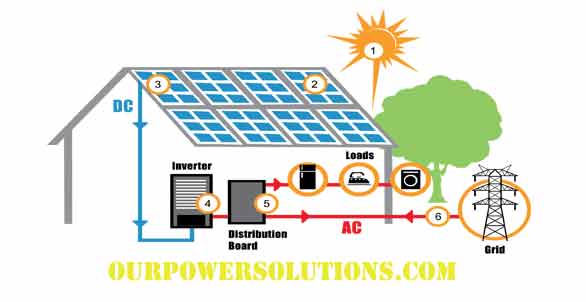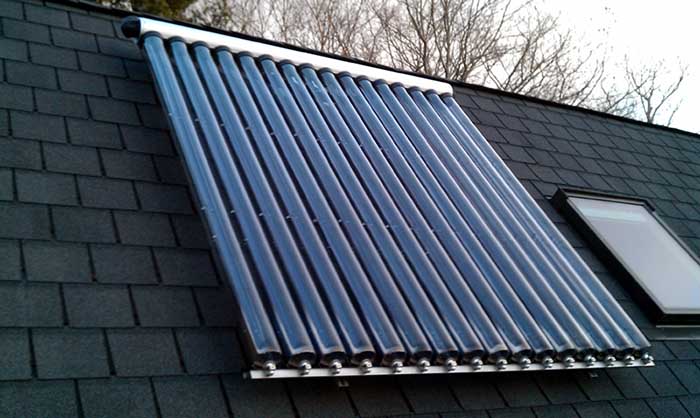Solar panels are a great way to reduce your carbon footprint and save money. They work by transforming sunlight into electricity through the use of photovoltaic cells. The solar panel is made up of two main parts, the solar cell or cells that capture energy from sunlight and turn it into electricity, and an inverter that converts direct current (DC) power to alternating current (AC). By using solar panels you can have access to cheap electricity to power your home without having any negative impact on the environment.

Step 1: Sunshine
Solar panels require sunshine in order to produce a charge. This is because they use a technology called photovoltaics – generation of voltage from light particles (PV). Photons are produced by the sun and are beamed into our atmosphere as light particles.
Step 2: Solar Panel
The Solar panels collect the light and turn it into a current. The photons from the light particles hit the photovoltaic panels that are essentially creating a current from the dislodged electrons from the semiconductor material.
Attaching a wire will harness the free electrons in the form of a charge. The current is a DC (Direct current) that can be used directly for some devices or stored in a battery bank.
Step 3: Battery
The current from the panel can then be stored in a battery until it’s needed later on. A battery bank is made of identical batteries wired in series or parallel and amps managed by connection switches. The bank should keep your loads running for hours and days according to how you size it.
Step 4: DC to AC Power
The power in the battery is still in the form of a direct current and cannot be used for AC applications. That’s where an inverter comes in. An inverter will convert the DC power from the bank or the panel to an Alternating Current (AC).
Step 5: Your Homes Electrical Panel
Your inverter will connect to your home’s main electrical panel and provide it with power. Solar electricity from your inverter flows to the electrical panel, and then into to your home where it powers your lights and appliances.
Step 6. Feeding it back to the grid.
If you generate more power than you need some utilities to allow you to feed it to the grid. These utilities will pay homeowners who feed them energy at times when demand exceeds supply — like during hot summer afternoons when everyone turns on their air conditioners. This is done through a meter that measures the amount of energy you draw from the grid but also how much you feed to the grid.
How Inverter Size Affects the Size of the Solar Panels
The size and number of solar panels needed for an off-grid solar power system depend on the amount of power that needs to be generated to meet the demands of the loads, as well as the climate and sunlight conditions in the location where the system will be installed.
The inverter’s capacity will determine how much power can be delivered to the loads, which in turn will determine how much power needs to be generated by the solar panels. If the inverter is too small, it may not be able to handle the power demands of the loads, which could lead to underperformance of the solar panels and batteries.
As a general rule of thumb, the size of your inverter should be similar to the DC rating of your solar panel system; if you are installing a 3 kilowatt (kW) system, you can expect the proposed inverter to be around 3000 W, plus or minus a small percentage.
There are two main types of setups when using inverters with Solar Panels; Grid-tied and Off-Grid systems.
Grid-Tied Inverter
In a Grid-tied system, your Solar power system is working alongside power supplied by your mains power. Solar Power is delivered to your home alongside power from your mains. If solar power is insufficient power switches back to grid power. The inverter constantly feeds power to your mains and the system works alongside your grid power. There are minimal interruptions in case of cloudy conditions and increased power demand.
Off-Grid Inverter
An Off-Grid inverter works in a stand-alone system without an external power source. In these setups Solar Panels charge a Battery Bank with DC power, the Inverter will convert the power from the batteries to AC power. This inverter will rely on the power from the batteries and if the batteries are depleted or get too hot there may be disruptions in the system.
You can also create a hybrid system and combine the two with an off-grid system when you have no power from the Grid and a Grid-tied inverter to supplement power from your solar system when there is high demand.
Types of Solar Energy Conversion
Basically, there are two approaches for the conversion of solar energy into useful energy. These approaches are solar thermal and photovoltaic.
Solar thermal
Solar thermal utilizes the energy from the sun to generate heat directly. It works by allowing energy from the sun to transfer directly through the surface of a fluid-filled panel.
The “solar thermal” is a collector and heat exchanger that allows direct conversion of solar energy into hot water or steam for space heating, swimming pools, or other uses.

Solar thermal panels work depending on being heated up enough to produce either hot water or vaporized fluid (steam) which can then be transferred between buildings for use inside those buildings.
It has been speculated that in one hour of peak sunshine, an average-sized system could produce about 24 gallons (95 liters) of boiling water for human consumption and other purposes like cooking food etc.
Photovoltaic
The other form of solar energy conversion is the Photovoltaic approach which we discussed before. Photovoltaic cells are made from silicon material and use light and not heat to produce electricity. This is different from the thermal approach.
Benefits of using Solar Energy
- Reduces Power bill
To begin with, there’s the obvious benefit of significantly reducing your energy bills. Once installed, solar panels generate completely free electricity. Solar energy can also be used for water heating which is one of the biggest consumers of power in our homes.
- Earn with Solar Energy
As mentioned before if you generate excess electricity on your solar panel system there are options of selling the excess to the grid which can earn you money.
- Tax Incentives
Incentives have been set up in order for more people to take up renewable energy. These tax incentives allow you to save up on your system.
- Increase the value of your home or business
PV systems require little maintenance and have warranties of up to 25 years. Many people are actually interested in setting up solar and purchasing a home that has them already installed is a plus. Therefore having a system already installed can make the value of your home or business increase.
- Saves the environment
Using renewable energy to cut down on fossil fuel emissions is a reliable source of sustainable power. By switching to an alternative source of power, you can help reduce pollution and the effects it has on Earth’s atmosphere.
Other Uses of Solar Energy
Solar energy can be used either directly or indirectly. Photovoltaic and Solar Thermal are examples of how Solar Energy is used directly. Indirect energy involves several steps to converting sunlight into useful energy an example is photosynthesis in plants.
Some other uses of solar energy include:
Lighting
We look forward to each morning starting our day with the free sunlight we get from the sun. Even moonlight comes from the sun as it can’t produce its own light. Light from the sun can make you feel healthier by producing a higher quality natural light that is easier on the eyes while soothing your mind with its warm glow.
Drying Laundry
Another obvious and day-to-day use of solar energy is drying clothes on hanging lines. Although wind also plays a part sunlight does play a big role in the drying of clothes.
It is also used as a form of curing vegetables that are sensitive to heat and dehydration, for the purpose of creating bottled products with local flavor. The purest form of solar drying does not use artificial energy, so it is in line with sustainability practices.
Photosynthesis in plants
Photosynthesis is one of nature’s wonders as it transforms unusable sunlight into usable sugar energy. In fact, all life on earth requires photosynthesis in order to survive.
As we all know about the recycling plan, carbon dioxide or CO2 gas becomes a positive resource as it becomes transformed into oxygen for us to breathe (O) and glucose for our cells to perform work. Scientists estimate that 95% of life on Earth relies on plants for food production.
Cooking
A solar cooker is a device that cooks food using the sun’s energy. There are many different types of solar cookers, with the most popular being in some form of box or container so that heat can be trapped inside.
The most common type is made up of a single reflector or smaller pieces of reflectors fixed to a frame forming a point focus to concentrate the sunlight and cook for. It is made of bright anodized aluminum sheets.
Heating homes
Some homes are designed in such a way to absorb heating from the sun. Homes in the Northern Hemisphere are designed with large windows facing southwards to better accommodate sunlight into the homes. Bringing much-needed light and also heating the home.
Water Distillation
Solar water distillation is a method for turning salt water into fresh, drinkable water. This process has been used in coastal regions around the world since ancient times. The recent rise of freshwater scarcity for drinking and farming has brought this particular need to global attention.
Solar energy comes with some great advantages but they are also some drawbacks. But using solar energy remains one of the best forms of alternative energy. Fossil fuels and natural gas will run out but the sun will still be out there in a billion years to come.
You are here
Leave a Reply